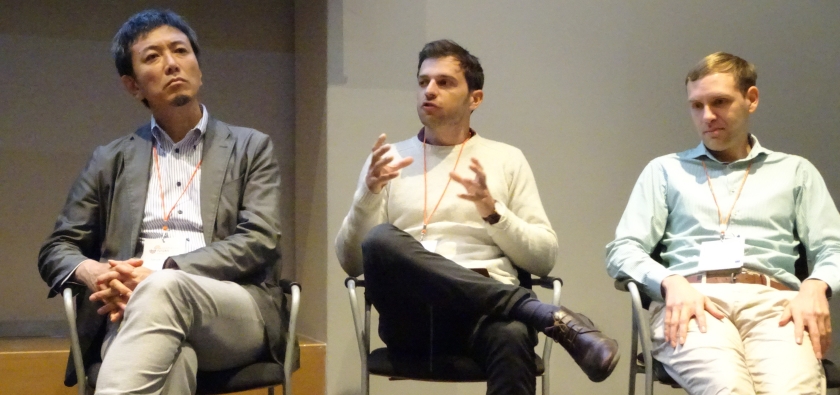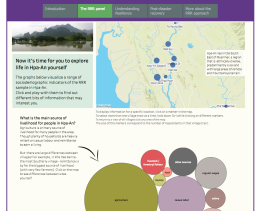
I’ve been fortunate to work on a wide range of issues spanning all aspects of climate change adaptation and disaster risk reduction.
 Much of this is borne from experiences in leading and managing large international research programmes, including: the Building Research and Adaptation to Climate Extremes and Disasters (BRACED) Rapid Response Research programme (RRR); the Future Climate For Africa (FCFA) scoping project; and Africa Climate Change Resilience Alliance’s research arm (ACCRA).
Much of this is borne from experiences in leading and managing large international research programmes, including: the Building Research and Adaptation to Climate Extremes and Disasters (BRACED) Rapid Response Research programme (RRR); the Future Climate For Africa (FCFA) scoping project; and Africa Climate Change Resilience Alliance’s research arm (ACCRA).
 Below is a snapshot of (and links to) some research outputs and assignments covered under these programmes, as well as details of what I’m currently working on.
Below is a snapshot of (and links to) some research outputs and assignments covered under these programmes, as well as details of what I’m currently working on.
DEFINING ADAPTATION AND RESILIENCE
-
- Identifying barriers to adaptation and resilience
- Creating new frameworks to describe concepts like adaptive capacity and maladaptation
—
OPERATIONALISING ADAPTATION, DRR AND RESILIENCE
-
- How can adaptation/DRR/resilience be measured?
- How should these terms be mainstreamed into policy and practice?
- What are the links between adaptation/DRR/resilience when it comes to operationalising them into development programming?
—
SUPPORTING THE UPTAKE OF CLIMATE INFORMATION IN DECISION MAKING
-
- How can climate science be embedded into long-term decision making across Africa and Asia?
- What are the constraints and enablers to the uptake of climate information in decision making?
—
DESIGNING MORE EFFECTIVE RESILIENCE-BUILDING PROGRAMMES
-
- How can adaptation research ensure greater relevance and use?
- Identifying the role of NGOs and other knowledge brokers in supporting climate services and the uptake of adaptation/resilience research
—
What was my PhD on?
After a number of years working in think tanks and policy-oriented research institutes I eventually took a plunge back in academia to do a PhD at LSE under Declan Conway.
My main focus was on the biggest buzzword of all: resilience. More specifically, I was interested in the potential for new tools to improve the way we measure whether people can deal with climate impacts and disasters in developing countries.
In particular, I focused on two innovations:
1) The potential for mobile phones to collect cheap and near-real-time survey data. The approach takes full advantage of the proliferation of mobile phone use across many development countries. It also allows data to be collected when people are on the move (crucial when trying to access people that temporarily relocate after a disaster).

Image: Jan Arendtsz
2) Exploring subjective evaluations of resilience (i.e. asking people to self-evaluate their own capacity to deal with climate risk). Resilience has traditionally been measured via objective means (i.e. people from the outside observing and measuring people). These are normally expert-driven affairs, that make large assumptions about the factors that support other people’s resilience.
Subjective tools take a very different approach. They make use of people’s knowledge of their own resilience and the factors that contribute to it. Tools for measuring subjective resilience seek to quantify levels of perceived resilience using standardised surveys (similar to how information on subjective wellbeing is collected).
 If these tools prove to be robust, then they may offer quicker, cheaper and more bottom-up ways of understanding and measuring resilience in post-disaster contexts.
If these tools prove to be robust, then they may offer quicker, cheaper and more bottom-up ways of understanding and measuring resilience in post-disaster contexts.
How did I collecting data?
A lot of my PhD research revolved around a BRACED programme called the Rapid Response Research project (RRR). The RRR took place in Myanmar, where in June 2017 we carried out a survey of 1200 households using a traditional face-to-face survey approach. At this point each household was given a mobile phone and a solar charger. At the same time, a call centre was set up in the capital, Yangon.
Each month participants were contacted via the call centre to collect important information relating to resilience and disaster risk. For households affected by monsoon flooding, this approach provided an easy and robust way of understanding how people recover in post-disaster contexts. Households were given a small financial incentive to take part (50c USD per completed survey) and answered the survey at a time of their choosing. This flexibility and convenience allowed the panel to maintain a response rate of 95% up to a year later – far higher than most traditional panel surveys.

Surveyors taking part in the first face-to-face surveys with households in Myanmar (future rounds of the survey take place over the phone via a mobile gifted to participants)
What am I investigating and why is it useful?
Using data collected under the RRR, ODI/BRACED colleagues and I sought to test whether subjective methods work and make sense to people on the ground. We also wanted to see if mobile phone data collection is adding value and providing accurate information.
Ultimately, the aim was to better understand what makes people resilient to the many risks that they face now and in the future. More importantly, we hope that insights from this work will be useful to NGOs, multilateral agencies and governments in being able to better target, deliver and monitor resilience-building activities to those who need it most.
How can you learn more about what we’ve finding and get involved?
To see some of the exciting results and findings from the RRR check out our interactive site: the Resilience Dashboard. It’s full of data visualisations, descriptions of the research and latest findings/blogs as they emerge.
If you want to jump straight into the specifics then see the list of reports in the Papers tab.
Specifically:
Jones, L., Ballon, P. 2020. Tracking changes in resilience and recovery after natural hazards: Insights from a high-frequency mobile-phone panel survey. Global Environmental Change. Available here (free pre-print) and here (journal link)
Jones, L. (2018). New methods in resilience measurement: early insights from a mobile phone survey in Myanmar using subjective tools. Overseas Development Institute. London: UK. Available here
Jones, L., Samman, E., Vinck, P. (2018). Subjective measures of household resilience to climate variability and change: Insights from a nationally-representative survey of Tanzania. Ecology and Society, 23(1). Available here
Clare, A., Graber, R., Jones, L., & Conway, D. (2017). Subjective measures of climate resilience: What is the added value for policy and programming? Global Environmental Change, 46, 17-22. Available here
Jones, L., Tanner, T. (2016). ‘Subjective resilience’: using perceptions to measure household resilience to climate extremes and disasters. Regional Environmental Change. 17: 229. doi.org/10.1007/s10113-016-0995-2. Available here



